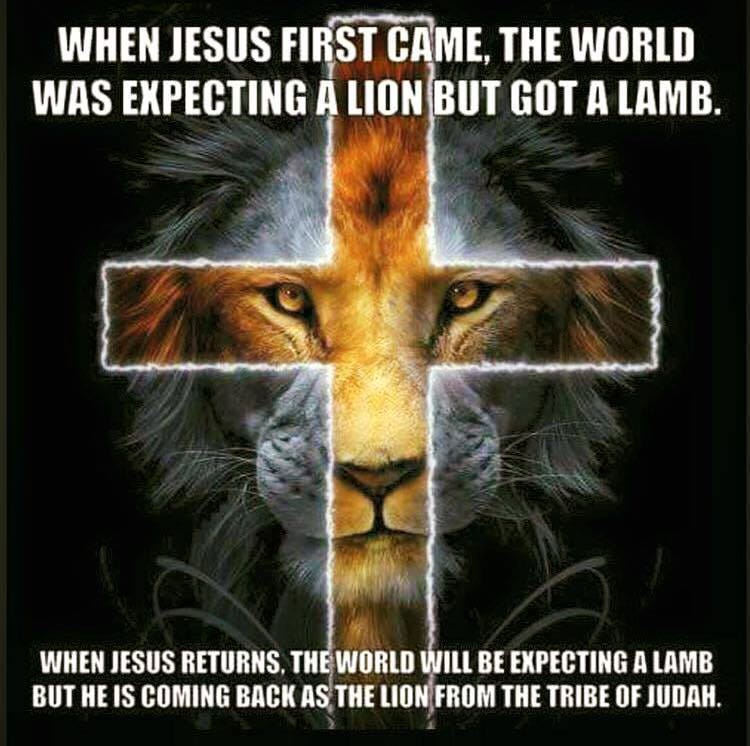Unmaking the Meme / Deshacer el meme
Jesus Doesn't Return as a Lion––and Here's Why That Matters / Jesús no vuelve como un león––y esto es porque eso importa
A frequently shared Bible meme says that Jesus first came as a Lamb, but he will return as a Lion. If you have evangelical friends and are on social media, you’ve probably seen something like this:
Varieties of this idea circulate widely, often without anyone stopping to ask whether they’re biblical. After all, many include a Bible reference––which is certainly Revelation 5:5: “Then one of the elders said to me, ‘Do not weep! See, the Lion of the tribe of Judah, the Root of David, has triumphed. . .’”
When a meme like this is shared, it’s often by people who study the Bible. Some will know that the image of the Lion of Judah comes from Genesis and that it later carried overtones of a victorious Messiah.
But to study the words of the verse without attending to what John is doing with the imagery in Revelation is to miss the point. The result is not just a minor detail or difference of opinion––it’s a misrepresentation of who Jesus is and how he “has triumphed.”
The idea that Jesus came as a Lamb and will return as a Lion may echo themes from some other talented authors––but not from John or anywhere else in the New Testament. Instead, think of numerous Westerns: a mysterious man arrives quietly and shows restraint but finally has enough of his enemies’ shenanigans and returns to brutally destroy every last one of them. “Came as Lamb, returning as Lion” might describe several of Clint Eastwood’s characters, but not the Jesus of Revelation.
Revelation 5:5 is the only place Jesus is called a Lion––because John uses the word to specifically subvert the expectation. John is told, “See, the Lion,” but when he looks, he sees “a Lamb standing as if it had been slaughtered.”
In contrast, Revelation calls Jesus the Lamb twenty-eight times. That is no accident. John wrote Revelation as a book about the Lamb, written for followers of the Lamb, who are called to follow the Lamb.
(Trying to capture the imbalance of the images visually, I turned to ChatGPT for help. What it produced is far closer to John’s message than the usual back-as-Lion memes––although John’s Lamb certainly isn’t as cutesy or weak:)
One of Revelation’s key patterns reinforces this: most of the time in Revelation, John sees something and then hears more. But eight times, the order is reversed––he hears first, and what he sees redefines what he was told.* For example:
John hears that 144,000 have been sealed from the tribes of Israel, but then sees a multitude that no one can count from every nation.
He is told to come and see “the bride, the wife of the Lamb,” and then is shown “the holy city Jerusalem coming down out of heaven.”
The pattern is clear: what he sees reconstructs the meaning of what he heard.
So here’s the spiritual formation question: Are we being shaped into the back-as-Lion image––a sheriff Jesus who will someday finally say “enough,” and go for the jugular?
Or are we being shaped into the image of the Lamb who has already conquered and invites everyone who wants to follow and conquer with him to come along and do so by taking up their own crosses?
–––
* I’m borrowing this insight about John’s order of hearing and seeing from Rebecca Skaggs and Thomas Doyle, "The Audio/Visual Motif in the Apocalypse of John Through the Lens of Rhetorical Analysis,” Journal of Biblical and Pneumatological Research, 3 (2011): 19-37.
For my academic treatment of this theme, see “The Slaughtered Lamb Shepherds with a Rod of Iron: The Use of Psalm 2:9 in Revelation” from the Journal of Inductive Biblical Studies.
Deshacer el meme: Jesús no vuelve como un león––y esto es porque eso importa
Un meme bíblico compartido con frecuencia dice que Jesús vino primero como Cordero, pero volverá como León. Si usted tiene amigos evangélicos y está en las redes sociales, es probable que haya visto algo como esto:
Variantes de esta idea circulan ampliamente, a menudo sin que nadie se pare a preguntar si son bíblicas. Al fin y al cabo, muchas incluyen una referencia bíblica, que sin duda es Apocalipsis 5:5: «Entonces uno de los ancianos me dijo: '¡No llores! Mira, ha triunfado el León de la tribu de Judá, la Raíz de David. . .'»
Cuando se comparte un meme como éste, a menudo lo hacen personas que estudian la Biblia. Algunos sabrán que la imagen del León de Judá procede del Génesis y que más tarde tuvo connotaciones de un Mesías victorioso.
Pero estudiar las palabras del versículo sin prestar atención a lo que Juan está haciendo con las imágenes del Apocalipsis es perder el punto. El resultado no es sólo un detalle menor o una diferencia de opinión––es una tergiversación de quién es Jesús y cómo «ha triunfado».
La idea de que Jesús vino como un Cordero y volverá como un León puede hacerse eco de temas de algunos otros autores de talento, pero no de Juan ni de ningún otro lugar del Nuevo Testamento. En cambio, piense en numerosas películas de vaqueros: un hombre misterioso llega en silencio y muestra moderación, pero finalmente se harta de las travesuras de sus enemigos y regresa para destruir brutalmente hasta el último de ellos. «Vino como Cordero, volverá como León» podría describir a varios de los personajes de Clint Eastwood, pero no al Jesús del Apocalipsis.
Apocalipsis 5:5 es el único lugar donde Jesús es llamado León - porque Juan específicamente usa la palabra para subvertir la expectativa. A Juan se le dice: «Mira, el León», pero cuando mira, ve «un Cordero de pie como si hubiera sido sacrificado».
En cambio, el Apocalipsis llama a Jesús el Cordero veintiocho veces. No es casualidad. Juan escribió el Apocalipsis como un libro sobre el Cordero, escrito para los seguidores del Cordero, que están llamados a seguir al Cordero.
(Para tratar de captar visualmente el desequilibrio de las imágenes, pedí ayuda a ChatGPT. Lo que produjo está mucho más cerca del mensaje de Juan que los memes comunes de volverá-como-León, aunque el cordero de Juan ciertamente no es tan cursi o débil:)
Uno de los diseños clave del Apocalipsis refuerza esto: la mayoría de las veces en el Apocalipsis, Juan ve algo y luego oye más. Pero ocho veces, el orden se invierte: primero oye, y lo que ve redefine lo que se le dijo.* Por ejemplo:
Juan escucha que 144,000 han sido sellados de las tribus de Israel, pero luego ve una multitud que nadie puede contar de cada nación.
Se le dice que venga y vea a «la novia, la esposa del Cordero», y luego se le muestra «la ciudad santa Jerusalén bajando del cielo».
El diseño es claro: lo que ve reconstruye el significado de lo que oyó.
He aquí la cuestión de la formación espiritual: ¿Estamos siendo formados en la imagen de un Jesús león, un Jesús sheriff que algún día dirá «basta» y se lanzará a la yugular?
¿O estamos siendo formados en la imagen del Cordero que ya ha vencido e invita a todos los que quieran seguirle y vencer con él a que vengan y lo hagan tomando sus propias cruces?
---
* Tomo prestada esta idea sobre el orden en que Juan oye y ve de Rebecca Skaggs y Thomas Doyle, «The Audio/Visual Motif in the Apocalypse of John Through the Lens of Rhetorical Analysis», Journal of Biblical and Pneumatological Research, 3 (2011): 19-37.
Para mi tratamiento académico de este tema, véase «The Slaughtered Lamb Shepherds with a Rod of Iron: The Use of Psalm 2:9 in Revelation» del Journal of Inductive Biblical Studies.






